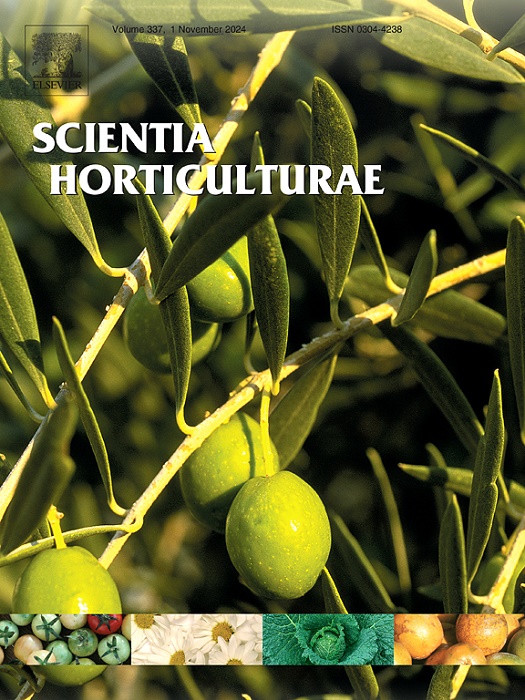蔬菜豌豆(Pisum sativum var hortense L.)耐高温胁迫基因型的表型、稳定性及适应性分析
IF 3.9
2区 农林科学
Q1 HORTICULTURE
引用次数: 0
摘要
气候变化促使豌豆育种者开发适应气候变化的高产品种,以适应各种条件。农民更喜欢可以早播或晚播的短生育期品种,这样可以最大限度地提高收益并支持复种。本研究评估了22种蔬菜豌豆基因型在5种环境下的高温胁迫(25-34℃),将植物暴露在营养和生殖阶段的胁迫下。与正常条件相比,应激条件(TS1:营养期TMax 34°C, TMin 21°C;最高温度32°C,最低温度15°C(花期),使荚果长度减少39.4%,株高减少70.7%,总荚果形成减少85.8%,每公顷荚果产量减少96.8%。根据HSI、TOL、MP、PYR和YSI 5个耐性指标,VRPE-955、Kashi Udai、VRPE-29、VRPE-30、Kashi Purvi和VRPE-944基因型在胁迫条件下荚果产量较高。性状关联分析表明,单株总荚果数、胚珠到种子的转化率、10荚重和荚果长是关键的选择性状。PCA结果表明,不同环境下各性状间的相关性存在差异,上述性状对PC1的负荷最大。利用AMMI和GGE双标图对VRPE-100、VRPE-30、VRPE-953、VRPE-955和VRPE-29进行稳定性分析,结果表明VRPE-100、VRPE-30、VRPE-955和VRPE-29具有较好的高温适应性。多性状稳定性指标表明,VRPE-953、VRPE-944和VRPE-18最稳定,适合在可变条件下复作。本文章由计算机程序翻译,如有差异,请以英文原文为准。

Phenotypic, stability and adaptation analysis of vegetable pea (Pisum sativum var hortense L.) genotypes for high-temperature stress tolerance
Climate change has driven pea breeders to develop climate-resilient, high-yielding cultivars suitable for a wide range of conditions. Farmers prefer short-duration cultivars that can be planted early or late, maximising returns and supporting multiple cropping. The present study evaluated 22 vegetable pea genotypes under high-temperature stress (25–34 °C) in five environments, exposing plants to stress during the vegetative and reproductive stages. Compared to normal conditions, stressed conditions (TS1: TMax 34 °C, TMin 21 °C at vegetative stage; TMax 32 °C, TMin 15 °C at flowering) resulted in 39.4 % reductions in pod length, 70.7 % in plant height, 85.8 % in total pod formation, and 96.8 % in pod yield/hectare. Based upon five tolerance indices viz., HSI, TOL, MP, PYR and YSI, the genotypes VRPE-955, Kashi Udai, VRPE-29, VRPE-30, Kashi Purvi and VRPE-944 exhibited high pod yield under stress conditions. Trait association analysis revealed that total pod formation/plant, ovule-to-seed conversion, 10-pod weight, and pod length are critical selection traits. PCA revealed that associations between traits varied across environments, with above-mentioned traits showing maximum loading on PC1. Stability analysis using AMMI and GGE biplots revealed that VRPE-100, VRPE-30, VRPE-953, VRPE-955, and VRPE-29 are well-adapted to high temperatures. Multi-trait stability indices showed that VRPE-953, VRPE-944, and VRPE-18 were the most stable, making them suitable for multi-cropping in variable conditions.
求助全文
通过发布文献求助,成功后即可免费获取论文全文。
去求助
来源期刊

Scientia Horticulturae
农林科学-园艺
CiteScore
8.60
自引率
4.70%
发文量
796
审稿时长
47 days
期刊介绍:
Scientia Horticulturae is an international journal publishing research related to horticultural crops. Articles in the journal deal with open or protected production of vegetables, fruits, edible fungi and ornamentals under temperate, subtropical and tropical conditions. Papers in related areas (biochemistry, micropropagation, soil science, plant breeding, plant physiology, phytopathology, etc.) are considered, if they contain information of direct significance to horticulture. Papers on the technical aspects of horticulture (engineering, crop processing, storage, transport etc.) are accepted for publication only if they relate directly to the living product. In the case of plantation crops, those yielding a product that may be used fresh (e.g. tropical vegetables, citrus, bananas, and other fruits) will be considered, while those papers describing the processing of the product (e.g. rubber, tobacco, and quinine) will not. The scope of the journal includes all horticultural crops but does not include speciality crops such as, medicinal crops or forestry crops, such as bamboo. Basic molecular studies without any direct application in horticulture will not be considered for this journal.
 求助内容:
求助内容: 应助结果提醒方式:
应助结果提醒方式:


